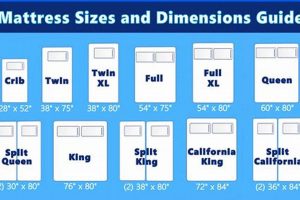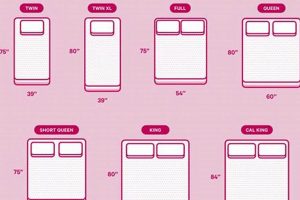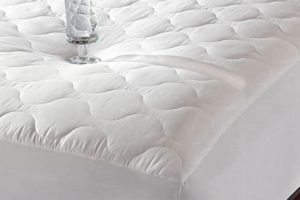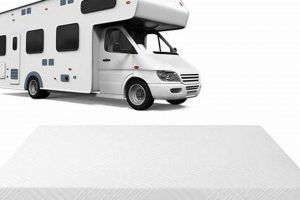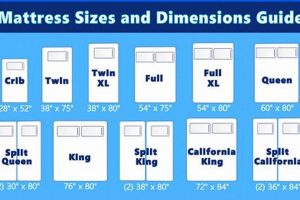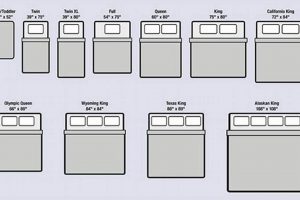The dimensions of a mattress designed for a daybed represent a crucial factor in selecting the appropriate bedding. These mattresses are typically sized to fit the unique frame of a daybed, often resembling a twin mattress in length and width, but potentially varying in thickness. For example, a standard daybed mattress will often measure approximately 39 inches wide and 75 inches long, mirroring the dimensions of a standard twin bed.
Proper mattress dimensions contribute significantly to both comfort and aesthetic appeal. A correctly sized mattress ensures optimal support and prevents unsightly gaps between the mattress and the frame. Historically, daybeds have served dual purposes, functioning as seating during the day and sleeping accommodations at night. Therefore, the selection of a suitably sized and comfortable mattress enhances the functionality and versatility of the furniture piece.
The following sections will explore in greater detail the various considerations involved in choosing appropriate dimensions for these mattresses, including factors such as frame compatibility, desired comfort level, and specific use-case scenarios. Detailed product information and available options in the market will also be addressed.
Daybed Mattress Size
Selecting the appropriate dimensions is critical for comfort, support, and aesthetics. The following considerations should be factored into the decision-making process.
Tip 1: Frame Compatibility is Essential. Prior to purchase, meticulously measure the interior dimensions of the daybed frame. The mattress must fit snugly within the frame to prevent shifting and ensure stability.
Tip 2: Consider Intended Use. Determine whether the daybed will primarily serve as a seating area or a sleeping surface. Mattresses intended for regular sleep should prioritize comfort and support, potentially requiring a greater thickness.
Tip 3: Evaluate Thickness Based on Support Requirements. Thicker mattresses generally provide increased cushioning and support. Individuals with back pain or those requiring enhanced pressure relief may benefit from a mattress with greater thickness.
Tip 4: Prioritize Material Quality. The materials used in construction significantly impact durability and comfort. Consider options such as memory foam, innerspring, or latex, each offering distinct advantages and disadvantages.
Tip 5: Account for Bedding. Factor in the thickness of any sheets, blankets, or mattress toppers when evaluating the overall profile of the mattress. This ensures the bedding fits properly and contributes to overall comfort.
Tip 6: Research Available Options. Explore various retailers and manufacturers to compare pricing, materials, and available warranties. Online reviews can offer valuable insights into the performance and durability of specific models.
Tip 7: Inspect Product Specifications. Always review the manufacturer’s specifications for precise dimensions. Slight variations can occur, even within standard sizing categories. Validate these specifications before finalizing the purchase.
By carefully considering these factors, one can ensure the chosen daybed mattress complements the frame, provides adequate support, and contributes to a comfortable experience.
The subsequent sections will delve into specific material types and offer advice on optimizing the lifespan of daybed mattresses.
1. Width Dimension
The width dimension of a daybed mattress dictates the available sleeping or seating surface area. As a component of overall size, an inaccurate width prevents the mattress from properly fitting within the daybed frame. For instance, if the frame’s interior width is 39 inches, a mattress exceeding this dimension will not fit. Conversely, a mattress significantly narrower than 39 inches leaves gaps, compromising both aesthetics and stability. This directly affects the comfort and usability of the daybed, whether as a lounging space or a bed.
The standard width for a daybed mattress typically mirrors that of a twin mattress, approximately 39 inches. However, variations exist depending on the daybed design. Some may accommodate a slightly wider or narrower mattress. When selecting a mattress, precise measurements of the daybed frame’s interior width are imperative. Failing to consider these measurements can result in purchasing a mattress that is unusable or necessitates costly alterations. The effect extends to the support provided; a mattress that isn’t fully supported by the frame due to incorrect width may sag prematurely.
In summary, understanding the width dimension is crucial for a successful daybed mattress purchase. It directly influences the mattress’s ability to fit the frame, impacting comfort, support, and longevity. Errors in assessing the width dimension can lead to functional issues and aesthetic compromises. Therefore, it is essential to accurately measure the interior dimensions of the daybed frame before selecting a mattress. Precise knowledge of this dimension ensures that the mattress integrates seamlessly with the furniture.
2. Length Specification
The length specification of a daybed mattress defines the distance from one end to the other, directly influencing the suitability and comfort of the sleeping or seating surface. As a critical dimension, the length must align with the daybed frame’s internal measurements to ensure proper fit and support.
- Standard Twin Length Correlation
The typical length specification for a daybed mattress aligns with a standard twin mattress, measuring approximately 75 inches. This standardization allows for greater availability and compatibility with existing bedding accessories. Deviations from this standard, even by a few inches, can lead to discomfort or instability if the mattress overhangs or leaves significant gaps within the frame.
- Impact on Occupant Comfort
The length specification directly impacts the comfort of the occupant. A mattress that is too short will not provide adequate support for the legs and feet, potentially leading to discomfort and restless sleep. Conversely, a mattress that is too long may not properly fit within the daybed frame, causing it to bow or sag. This consideration is particularly relevant for taller individuals who require a longer sleeping surface.
- Considerations for Frame Design
Different daybed frame designs may impose specific length requirements. Some frames feature enclosed ends or decorative elements that reduce the available space for the mattress. Therefore, it is imperative to measure the interior dimensions of the frame accurately and compare them to the mattress’s length specification. Ignoring these design constraints can result in purchasing an incompatible mattress.
- Material Influence on Perceived Length
The material composition of the mattress can also influence the perceived length. A firm mattress may feel shorter due to limited compression, while a softer mattress may conform to the body, effectively extending the usable length. This subjective element should be considered alongside the objective measurement when evaluating the suitability of a particular mattress. Factors such as mattress density and coil construction contribute to this effect.
In conclusion, the length specification is a fundamental aspect of daybed mattress size, intricately linked to frame compatibility, occupant comfort, and material properties. Adherence to the appropriate length dimensions ensures a seamless integration of the mattress with the daybed, maximizing both its aesthetic appeal and functional utility.
3. Thickness Variability
Thickness variability in daybed mattresses represents a significant factor affecting comfort, support, and overall suitability for the intended application. The mattress’s vertical dimension directly impacts its ability to conform to the body and provide adequate cushioning, thereby influencing sleep quality and ergonomic support.
- Impact on Support and Comfort
Mattress thickness directly correlates with the level of support provided. Thicker mattresses generally offer more substantial cushioning and are better suited for individuals requiring enhanced pressure relief, particularly those with back pain or joint issues. Conversely, thinner mattresses may provide adequate support for occasional use but may lack the comfort needed for prolonged sleeping. A thicker mattress also distributes weight more evenly, reducing pressure points. For example, a 4-inch mattress may be suitable for a child’s daybed, whereas an adult may require a 6-inch or 8-inch mattress for optimal support.
- Compatibility with Daybed Frame Design
Daybed frame designs often dictate permissible mattress thickness. Some frames feature a trundle unit or storage compartments underneath, which limit the available vertical space. Selecting a mattress that exceeds the frame’s capacity can hinder the proper operation of these features or result in an aesthetically unappealing appearance. Conversely, a mattress that is too thin may leave excessive gaps between the mattress and the frame, compromising stability and visual appeal. For instance, a daybed designed to resemble a sofa during the day may require a thinner mattress to maintain the desired aesthetic.
- Material Composition and Durability
Thickness variability is intrinsically linked to material composition and durability. Thicker mattresses often incorporate multiple layers of different materials, such as memory foam, latex, and high-density support foam, to enhance comfort and support. These layered constructions tend to exhibit greater resistance to compression and sagging over time, extending the mattress’s lifespan. Thinner mattresses, with fewer material layers, may be more susceptible to wear and tear, requiring more frequent replacement. A mattress with a substantial base layer of high-density foam will provide more durable support than a thinner one consisting solely of low-density materials.
- Influence on Aesthetics and Functionality
Mattress thickness significantly influences the overall aesthetic of the daybed, particularly when used in a multi-functional space. A thicker mattress may give the daybed a more substantial and luxurious appearance, while a thinner mattress may create a more minimalist or understated look. Functionally, the thickness can affect the ease with which the daybed transitions between seating and sleeping configurations. A thicker mattress may be more difficult to maneuver or store if the daybed features a folding or retractable design. Careful consideration of the intended use and aesthetic preferences is essential when selecting a mattress with appropriate thickness.
In conclusion, the thickness variability of daybed mattresses constitutes a crucial determinant of comfort, support, durability, and aesthetic compatibility. Evaluating these factors in conjunction with individual needs and preferences ensures the selection of a mattress that optimally complements the daybed frame and fulfills its intended purpose. The relationship of thickness to other dimensional aspects is a key consideration.
4. Frame Compatibility
Frame compatibility, in the context of daybed mattress size, refers to the dimensional and structural congruence between the mattress and the daybed frame. Proper compatibility is essential for ensuring optimal support, preventing damage to both the mattress and the frame, and maintaining the intended aesthetic of the daybed. Misalignment in dimensions or structural characteristics can lead to discomfort, instability, and reduced lifespan of the furniture.
- Dimensional Alignment
Dimensional alignment constitutes the primary facet of frame compatibility. The mattress’s length, width, and thickness must precisely correspond to the interior dimensions of the daybed frame. A mattress that is too large will not fit, potentially damaging the frame or mattress during attempted insertion. Conversely, a mattress that is too small will leave gaps, compromising support and creating an unstable sleeping or seating surface. The frame’s internal dimensions must be accurately measured before selecting a mattress. Example: A frame designed for a 39″ x 75″ mattress will not accommodate a 40″ x 76″ mattress, nor will it provide adequate support for a 38″ x 74″ mattress.
- Support Structure Congruence
The support structure of the daybed frame must be adequate for the mattress type and anticipated weight load. Slatted frames, for instance, require sufficient spacing and strength to prevent sagging or uneven support. Solid platform frames provide more uniform support but may not be suitable for mattresses requiring ventilation. The mattress’s weight distribution characteristics must be considered in relation to the frame’s design. Example: A heavy memory foam mattress may require a frame with closely spaced slats to prevent premature sagging, while a lighter innerspring mattress may be adequately supported by a frame with wider slat spacing.
- Edge Support Integration
The frame’s edge support design should complement the mattress’s edge support construction. Some frames feature raised edges or side rails to prevent the mattress from shifting or sliding. The mattress’s edge support, often achieved through reinforced coils or foam encasements, must be sufficient to maintain its shape and stability when the daybed is used for seating. Mismatched edge support can lead to premature wear and tear on the mattress edges. Example: A daybed frame with minimal side rails requires a mattress with robust edge support to prevent the edges from collapsing when someone sits on them.
- Thickness Accommodation
The frame’s design must accommodate the mattress’s thickness without compromising functionality or aesthetics. Frames with trundle units or storage compartments underneath have limited vertical clearance, necessitating a thinner mattress. Conversely, frames designed to resemble sofas may require a thicker mattress to achieve the desired seating height and comfort level. Inadequate thickness accommodation can hinder the operation of trundle units or create an awkward visual appearance. Example: A daybed with a pull-out trundle bed underneath requires a thinner mattress on the upper frame to allow sufficient clearance for the trundle to roll out smoothly. A thicker mattress may obstruct the trundle’s movement.
In summary, frame compatibility is a multifaceted consideration integral to the successful selection and utilization of a daybed mattress. Dimensional alignment, support structure congruence, edge support integration, and thickness accommodation must be carefully evaluated to ensure optimal performance, longevity, and aesthetic harmony. Failure to address these aspects can result in discomfort, damage, and reduced lifespan of both the mattress and the daybed frame. Considering the specific frame design and intended use of the daybed is paramount for achieving optimal frame compatibility.
5. Weight Capacity
Weight capacity is a crucial, often overlooked, component directly influenced by the dimensions and materials constituting a daybed mattress. The size of the mattress, particularly its thickness and overall surface area, contributes to its ability to distribute weight effectively. For instance, a thicker mattress, inherently larger in volume, typically incorporates a greater density of support materials, leading to a higher weight capacity. This capacity dictates the maximum load the mattress can bear without compromising its structural integrity or long-term performance. Exceeding the weight limit can result in premature sagging, uneven support, and a diminished lifespan for both the mattress and the daybed frame. The weight capacity therefore is tied to the volume of high density materials within the mattress.
The practical significance of understanding weight capacity becomes evident when considering various user scenarios. A single adult, or two children, within weight capacity, will cause a certain expected displacement. Two adults, or one adult with children in excess of weight capacity, will cause a greater, potentially damaging, displacement. The distribution of weight across the mattress surface also plays a role; concentrated weight in one area may lead to localized stress and accelerated wear. Knowledge of the weight restrictions allows for informed decisions regarding usage and helps prevent damage, ensuring the daybed serves its intended purpose safely and effectively. The weight capacity is often printed directly on the mattress.
In summary, weight capacity is not merely an ancillary specification but an integral attribute directly linked to the dimensions and construction of the mattress. It is a crucial consideration for maximizing the longevity, safety, and comfort of the daybed. Users must carefully evaluate the anticipated weight load and ensure that the selected daybed mattress offers an adequate weight capacity to avoid premature degradation and potential structural failure. These specifications are often overlooked, to the detriment of the investment and longevity of the product. Understanding these implications allows for informed purchase decisions and prolonged product lifecycles.
6. Support System
The support system within a daybed mattress is intrinsically linked to its overall size, influencing factors such as comfort, durability, and suitability for various uses. The size dimensions of the mattress directly impact the design and effectiveness of its internal support components.
- Coil Density and Distribution
Coil density, referring to the number of coils per unit area, directly correlates with the support provided by an innerspring mattress. A higher coil density, typically found in thicker mattresses, distributes weight more evenly, minimizing pressure points and enhancing spinal alignment. For example, a daybed mattress intended for regular use may benefit from a higher coil count, whereas one intended for occasional use may suffice with a lower density coil system. Insufficient coil density within too small a mattress size can lead to premature sagging and inadequate support, particularly for heavier individuals.
- Foam Density and Layering
Foam density, measured in pounds per cubic foot, determines the resilience and longevity of foam-based support systems. Higher-density foams, often incorporated into thicker daybed mattresses, offer superior support and resist compression over time. Layering different foam types, such as memory foam over high-density support foam, allows for a balance of comfort and support. A daybed mattress size of insufficient thickness limits the capacity for multiple foam layers, potentially compromising long-term support. For example, a thinner foam mattress might lack the necessary support for side sleepers, resulting in discomfort and spinal misalignment.
- Edge Support Mechanisms
Edge support systems, crucial for preventing mattress sagging and facilitating ease of entry and exit, are directly affected by the mattress size. Larger daybed mattresses often incorporate reinforced edge supports, such as high-density foam rails or additional coils along the perimeter. These mechanisms enhance stability and expand the usable sleeping surface. A smaller mattress size may necessitate simpler edge support designs, which may not provide adequate support for individuals who frequently sit or sleep near the edge of the daybed. Without edge support, the sleeper will be ejected from the mattress surface more readily.
- Zoning and Targeted Support
Zoned support systems, designed to provide varying levels of support to different areas of the body, are often integrated into higher-end daybed mattresses. These systems utilize different coil gauges, foam densities, or support structures to target specific pressure points, such as the shoulders and hips. The effectiveness of zoned support depends on the mattress size and the correct placement of support zones. Smaller mattress sizes may limit the ability to implement complex zoning strategies, potentially compromising customized support. A daybed mattress with a well-defined zoning system will properly support the back, regardless of sleeping position.
In essence, the support system within a daybed mattress is intimately connected to the mattress’s dimensions. Coil density, foam layering, edge support mechanisms, and zoning strategies are all influenced by the overall size, impacting comfort, durability, and the mattress’s ability to provide adequate support. Careful consideration of these interconnected factors is essential for selecting a daybed mattress that meets specific needs and preferences.
7. Edge Support
Edge support, as it relates to daybed mattresses, signifies the structural reinforcement along the perimeter of the sleep surface. This feature directly counteracts the propensity for compression and sagging that naturally occurs near the edges of the mattress, particularly under concentrated weight. The degree of edge support is intrinsically linked to the mattress’s overall size; larger mattresses often necessitate more robust edge support systems to maintain structural integrity, whereas smaller mattresses may require less reinforcement due to reduced surface area and weight distribution. Inadequate edge support results in a diminished usable sleep surface, difficulty in entering and exiting the daybed, and an increased risk of rolling off the edge during sleep. For example, a daybed mattress measuring 39 inches by 75 inches with insufficient edge support might effectively offer only 30 inches of usable sleeping width due to edge collapse.
The composition of edge support varies, commonly employing high-density foam encasements, reinforced coils, or metal frames along the mattress perimeter. High-density foam provides consistent support and is often found in memory foam mattresses. Reinforced coils offer a more traditional approach, utilizing thicker gauge coils to resist compression. Metal frames provide the most rigid support but can impact the overall comfort and flexibility of the mattress. The effectiveness of each method is predicated on the mattress’s size and the anticipated weight load. Consider a daybed frequently used for seating; the edges are subject to sustained pressure. Consequently, a robust edge support system becomes paramount to prevent premature degradation. This is particularly critical in smaller-sized daybed mattresses where the edge represents a larger proportion of the overall sleep surface. Without edge support, the perimeter coils will bend.
Understanding the interplay between edge support and mattress size is essential for informed purchasing decisions. Selecting a daybed mattress with inadequate edge support, relative to its dimensions and intended use, leads to compromised comfort, reduced durability, and a diminished sleep experience. Evaluating the composition, strength, and integration of the edge support system, in relation to the mattress’s size specifications, ensures optimal performance and longevity. The lack of adequate edge support, directly resulting from poor dimensions, leads to a short lifespan and uneven sleeping surface. Therefore, evaluation of edge support dimensions is vital to making a quality daybed mattress purchase.
Frequently Asked Questions
This section addresses common inquiries regarding the dimensions and specifications of mattresses designed for daybeds, providing factual and objective information to aid in informed decision-making.
Question 1: What are the standard dimensions for a daybed mattress?
The most prevalent dimensions for a daybed mattress mirror those of a standard twin mattress, measuring approximately 39 inches in width and 75 inches in length. However, variations may exist to accommodate specific daybed frame designs.
Question 2: How does mattress thickness affect daybed functionality?
Mattress thickness influences both comfort and compatibility with daybed frames. Thicker mattresses provide enhanced cushioning but may not fit within frames featuring trundle units or storage compartments. Careful consideration of the frame’s vertical clearance is essential.
Question 3: Is edge support a critical factor in daybed mattress selection?
Edge support is indeed a significant consideration. Robust edge support prevents sagging and maximizes the usable sleep surface, particularly when the daybed is frequently used for seating. Insufficient edge support compromises stability and reduces the mattress’s lifespan.
Question 4: How does the weight capacity of a daybed mattress relate to its size?
The overall dimensions and internal construction of a daybed mattress directly influence its weight capacity. Thicker mattresses with denser support materials generally exhibit higher weight capacities. Exceeding the stated weight limit can lead to premature wear and tear.
Question 5: What type of support system is most appropriate for a daybed mattress?
The ideal support system depends on the intended use and individual preferences. Innerspring systems offer traditional support, while memory foam provides enhanced pressure relief. Hybrid mattresses combine both technologies for a balance of comfort and support. Coil density is a prime concern.
Question 6: How do I accurately measure my daybed frame to ensure proper mattress fit?
Accurate measurement requires determining the interior dimensions of the frame, from edge to edge. Account for any structural elements that may reduce the available space. Consulting the manufacturer’s specifications for the frame is also advisable. Measure length and width.
Properly sized and supportive mattresses are essential to the longevity of the product.
The subsequent section will provide detailed information about maintenance strategies.
Conclusion
This examination of daybed mattress size has underscored the critical interplay between dimensions, construction, and intended use. Proper size selection, encompassing length, width, and thickness, is paramount for ensuring optimal comfort, adequate support, and seamless integration with the daybed frame. Factors such as edge support, weight capacity, and internal support systems are directly influenced by the mattress’s dimensions, affecting its overall performance and longevity. The article has illuminated that the overall value of a daybed is dependent on the size.
Therefore, diligent consideration of these interconnected elements is essential for making informed purchasing decisions. A carefully chosen mattress, appropriately sized and constructed, contributes to a durable and functional daybed that meets individual needs and preferences. Prioritizing these considerations maximizes the investment and ensures a comfortable and supportive sleep or seating experience for years to come. Selecting the proper size is crucial for the enjoyment of this type of product.


